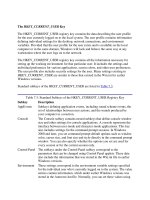Tài liệu The Change Problem doc
Bạn đang xem bản rút gọn của tài liệu. Xem và tải ngay bản đầy đủ của tài liệu tại đây (110.71 KB, 4 trang )
The Change
Problem
The Change Problem by Kevin McManus
First published in Industrial Engineer magazine August 2003
“If you want to
retain those who
are present, be
loyal to those who
are absent.”
-- Dr. Stephen Covey,
The Seven Habits of
Highly Effective People
“Learning cannot
be disassociated
from action.”
-- Peter Senge, The Fifth
Discipline
“The most
important
measures are
both unknown and
unknowable.”
-- W. Edwards Deming,
Out of the Crisis
One of the best attended sessions at the 2003 IE Solutions conference, which was held in Portland,
Oregon, dealt with the topic of getting people to change their behaviors in support of workplace
improvements. After over twenty years in business, I have yet to see this topic not be a popular
one, and I continue to see people flock to such sessions in search of the answer to the “How do we
motivate people to change?” question.
In an ideal world, the answer to this question would be simple – define the desired results in clear
terms, let people know what the benefits of obtaining this result will be, provide them with the
necessary support to help facilitate the change, let them know what the consequences of failing to
obtain the results will be, and effectively recognize them if and when they are successful. As we are
working with mature adults, these actions should be the only ones we have to undertake in order to
accomplish what we need. That said, one might wonder “If it is that simple, why do we have such
problems getting people to change?”
Possible answers include the facts that we often fail to define our expectations clearly, we fail to
provide true, effective support, and we often do not recognize people effectively. I feel the larger
breakdown however can be found in the fact that we often fail to define significant consequences
for failing to perform, and worse yet, we fail to follow-up on the execution of such consequences in
those cases where they need to be enacted.
There are really only four main types of consequences that we as members of management can
use as leverage to encourage change. The most commonly employed consequence involves
nagging about the need to change. As I mentioned in a previous article however, nagging rarely
works, is time consuming, and often results in people only doing the minimum needed in order to
get us to stop bothering them.
On the other end of the consequence spectrum, we can threaten people with their jobs if they fail to
change. In today's litigious society however, this option is hard to follow through on, and the use of
this approach usually creates a lot of fear in the workplace in those cases where it is used.
Additionally, good employees are getting harder and harder to find, so we are often reluctant to let
a resistant employee go, knowing full well that their replacement might be even more of a problem.
We can also appeal to their sense of company in an effort to motivate. I have often seen
consequences of this nature used on personal development plans, at more than one organization.
In other words, people are told that failing to put a given change in place will result in the company
not obtaining its goals. While this angle would appear to be effective from a conceptual perspective,
it really only works when people have a highly vested interest in the performance of the company
(what's in it for me?).
Somewhere between constant nagging and the threat of job loss lies the option of using discipline. I
don't know about you, but whenever I hear this word used, I think back to when I was a child and
my parents were about to discipline me. Since timeouts, spankings, and being grounded are not
really options that we can use at work, I really struggle to define meaningful forms of workplace
discipline that can be used on a regular basis. We could make Joe stand in the corner for failing to
complete his paperwork correctly, but I doubt that this approach would do much to motivate Joe
over the long term.
We can threaten to take someone off of a job, restrict their ability to receive overtime work, or make
them do work that is less than desirable as punishment, but does the use of these consequences
really keep the problem behavior from reoccurring? We still have people who yell at other people at
work when they fail to meet an expectation, but does this consequence help us correct problem
behaviors? It has been my experience that more often than not that yelling or nagging merely
creates a situation where the employee will make sure that the mistake is not detected again by
management in the future.
Conventional wisdom teaches us to use progressive discipline in order to get people to follow the
rules. As we progress from verbal warning to written warning, and in some cases to the latter two
steps of suspension and termination, we really do not do a lot to build the capacity for improvement
in our organizations. People will do what they need to do to stay out of trouble – they know the
restrictions that management has in terms of keeping an eye on them every minute of each day.
In order to motivate people, they have to agree that it is important that something gets done a
certain way. You also have to give them regular feedback (non-threatening of course) when they
fail to meet your expectations or do a good job of meeting them. We can base our list of possible
consequences on denying people privileges or taking away things they enjoy, but doing so will not
motivate them to consistently meet expectations over the long term. The focus instead will be on
staying out of trouble.
We hear talk about needing to hold people accountable – have we not lost if we as human beings
can no longer be trusted to hold ourselves accountable? We like to think that if a supervisor is
present, then everyone will follow the rules, but in reality, we supervisors are human ourselves. We
cannot be everywhere at once, and we cannot keep an eye on every employee action. We must
create systems that drive internal accountability, or we are destined to be parents even after our
children have grown up.
If you treat your people like children, you will get childish behavior. If you treat them like the adults
that they are, most will act like adults. There will always be a percentage of the workforce that will
try to cut corners no matter what, but if you have a solid hiring process, a fair compensation
process, a balanced measurement approach, and clearly defined expectations, this percentage
should be relatively small.
The consequences of failing to follow procedures, to treat all customers with respect, and to seek
for ways to make each job better is a dying or dead organization. The connection however between
personal actions and the demise of the company however is very difficult for most people to make.
As management, we have an obligation to make sure that our people know why change is
necessary – we need to find ways to make our priorities consistent with theirs. Otherwise, we are
destined to keep flocking to sessions on making people change in search of “the answer”.
Would You Like to Learn More?
Click on one of the following links to learn even more about Great Systems! and the types of
systems improvements I can help you make:
Great Systems! home page
More articles on performance improvement
Systems Change: The Key to Getting Better Results
Do You Need Great Systems!
Types of Systems I Can Help You Improve









